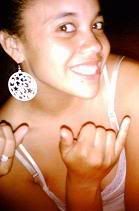Plankton is a little creature that lives in the ocean. There do not have the ability to swim aganist the current. Plankton is so important becuase if we did not have it we would have all the animals that live in the ocean. We studied plankton to learn how important plankton is in our lifes. We also studied it to learn about the food web and how plankton relates to it. It also helped us understand that if we didn't have plankton we would have other animals in the ocean.
For this experiment we went to the Kihei Boat Ramp to do are studys. Our group towed a plankton next on the South dock at Kihei Boat Ramp. When were done we emptyed the water and put it into are samples. We used those samples to identify three major planktons (copepods, arrow worms and acanthometras). We took two more additional samples to identify the specimens. While we were there we took the temperature by using a digital thermometer. We also found out the turbidity by sticking the test tube with the secchi disk into the water and emptying out water until we could see the disk. We used a refractometer to check the salinity. At the end of the class we didn't have enough time to look at our specimens under the Proscope so we put are samples into the refrigerator. Then the next day we did are studies. We took are samples and put them into a petri dish and view them under the Pro scop which projected onto the laptop. We then counted all the specimens so we could get a rough estimate on what types of planktons there were in the water. We found out that t majority of are samples contained copepods. So to answer are essential question, there are more copeopods in our sample then arrow worms and acanthometras. There are some pictures and graphs from our studies.
 This is a picture of my group when we were at Kihei Boat Ramp. Our group sampled the different type of samples at Kihei Boat Ramp.
This is a picture of my group when we were at Kihei Boat Ramp. Our group sampled the different type of samples at Kihei Boat Ramp. This is a graph of my first sample from the Kihei Boat Ramp. There was more copeopods than arrow worms and acanthometra in our sample.
This is a graph of my first sample from the Kihei Boat Ramp. There was more copeopods than arrow worms and acanthometra in our sample. This is a graph of my second sample from Hookipa. There were only arrow worms in this sample.
This is a graph of my second sample from Hookipa. There were only arrow worms in this sample. This is a graph of my third sample from Kihei Boat Ramp. There were only copepods in our sample.
This is a graph of my third sample from Kihei Boat Ramp. There were only copepods in our sample.
1 comment:
Great job Kristin! I like the picture and graphs. The info is very good as well. Though I think you meant to say that without plankton, there wouldn't be any other animals in the ocean. Plankton rules! Keep up the good work. Ms. V
Post a Comment